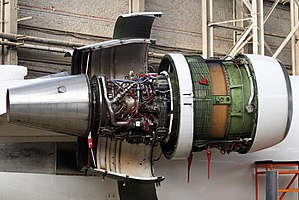General Electric CF34
| CF34 | |
|---|---|

|
|
| A CF34 installed on a Bombardier CRJ200 | |
| Type | Turbofan |
| National origin | United States |
| Manufacturer | General Electric |
| First run | 1982 |
| Major applications |
Bombardier Challenger 600 series Bombardier Challenger 850 Bombardier CRJ Comac ARJ21 Embraer E-Jets |
| Developed from | General Electric TF34 |


The General Electric CF34 is a civilian high-bypass turbofan developed by GE Aircraft Engines from its TF34 military engine. The CF34 is used on a number of business and regional jets, including the Bombardier CRJ series, the Embraer E-Jets, and Comac ARJ21. In 2012, there were 5,600 engines in service.
Design and development
The original engine contained a single stage fan driven by a 4-stage low pressure (LP) turbine, supercharging a 14-stage HP compressor driven by a 2-stage high pressure (HP) turbine, with an annular combustor. Later higher thrust versions of the CF34 feature an advanced technology core, with only 10 HP compressor stages. Latest variants, the -10A and -10E, were derived from the CFM56 engine family, and have a radically different HP spool, containing a 9-stage compressor driven by a single stage turbine. The LP spool has 3 core booster stages behind the fan. Static thrust is 82 kilonewtons (18,500 lbf) for the -10E variant.
On wing times can reach 14,000 hours, an overhaul costs over $1.5 million and a set of LLPs $2.1 million for a 25,000 cycle life. In 1995, GE invested $200 million to develop the -8C derivative for the CRJ700.
GE had proposed updating the Boeing B-52 Stratofortress with CF34-10 engines, but the Rolls-Royce F130 was selected in September 2021 instead.
Applications
- CF34-1A
- CF34-3A
- CF34-3A1
- CF34-3A2
- CF34-3B
- CF34-3B1
- CF34-3B
- CF34-8C1
- CF34-8C5
- CF34-8C5A1
- CF34-8C5A2
- CF34-8C5B1
- CF34-8E
- CF34-10A
- CF34-10E
Specifications
| CF34-3 | CF34-8C | CF34-8E | CF34-10A | CF34-10E | |
|---|---|---|---|---|---|
| Application | CL600/CRJ200 | CRJ700/900/1000 | E170/175 | ARJ21 | E190/195 |
| Length | 103 in (2.6 m) | 128 in (3.3 m) | 121 in (3.1 m) | 90 in (2.3 m) | 145 in (3.7 m) |
| Diameter | 49 in (1.2 m) | 52 in (1.3 m) | 53 in (1.3 m) | 57 in (1.4 m) | 57 in (1.4 m) |
| Dry weight | 1,670 lb (760 kg) |
2,400–2,450 lb (1,090–1,110 kg) |
2,600 lb (1,200 kg) |
3,700 lb (1,700 kg) |
3,700 lb (1,700 kg) |
| Fan | 44 in (110 cm) | 46.2 in (117 cm) | 53 in (130 cm) | ||
| Compressor | 14 HP stages, 14:1 | 10 HP stages | 3 LP + 9 HP stages | ||
| Turbine | 4 LP + 2 HP stages | 4 LP + 1 HP stage | |||
| Thrust (SL) | 9,220 lbf (41.0 kN) | 13,790–14,500 lbf (61.3–64.5 kN) | 14,500 lbf (64 kN) | 17,640 lbf (78.5 kN) | 20,360 lbf (90.6 kN) |
| Thrust/weight | 5.52:1 | 5.7-6:1 | 5.6:1 | 5.1:1 | 5.2:1 |
| OPR (max. power) | 21:1 | 28-28.5:1 | 28.5:1 | 29:1 | |
| Bypass ratio | 6.2:1 | 5:1 | 5.4:1 | ||
| SFC (Cruise) | 0.69 lb/lbf/h (20 g/kN/s) |
0.67–0.68 lb/lbf/h (19–19 g/kN/s) |
0.68 lb/lbf/h (19 g/kN/s) |
0.65 lb/lbf/h (18 g/kN/s) |
0.64 lb/lbf/h (18 g/kN/s) |
See also
Related development
Comparable engines
- PowerJet SaM146
- Progress D-436
- Pratt & Whitney PW6000
- IAE V2500
- Rolls-Royce AE 3007
- Rolls-Royce BR700
- Rolls-Royce RB.183 Tay
Related lists